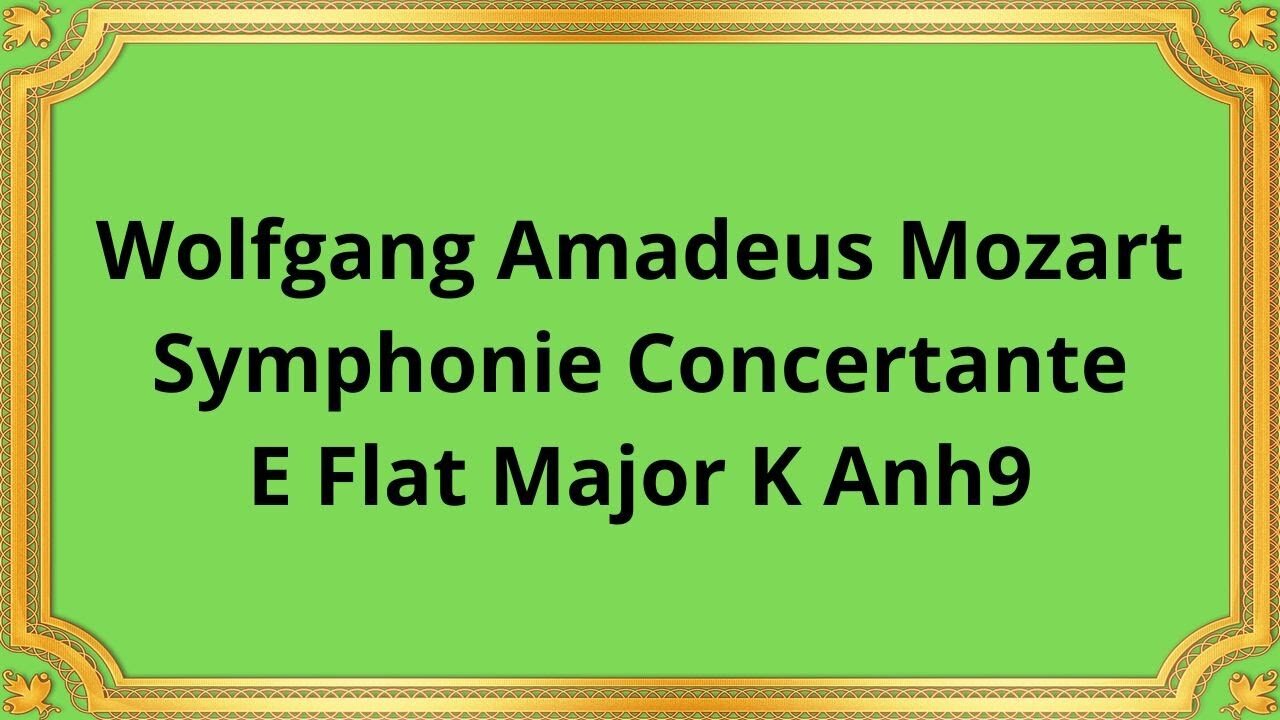Premium Only Content

Wolfgang Amadeus Mozart Symphonie Concertante E Flat Major K Anh9
#Mozart#Chamber_music#Classical_music#Symphony#Musical_composition
Publication date 1950
VIENNA PHILHARMONIC WIND GROUP
and CHAMBER ORCHESTRA of the VIENNA STATE OPERA
Conducted by HENRY SWOBODA
Wolfgang Amadeus Mozart is known for his contributions to the classical music genre, and his Symphonie Concertante E Flat Major K Anh 9 is no exception. Composed in the late 18th century, this work is a showcase of Mozart's musical talent, both as a composer and as a performer. In this article, we will delve into the composition of Mozart's Symphonie Concertante E Flat Major K Anh 9 and explore its significance in the classical music world.
Mozart composed the Symphonie Concertante E Flat Major K Anh 9 in 1779, during his tour of Europe as a child prodigy. The work was likely commissioned by one of Mozart's patrons and was intended to be performed by a small orchestra.
The Symphonie Concertante E Flat Major K Anh 9 is written for four solo instruments: violin, viola, cello, and French horn. It is composed of three movements:
Allegro maestoso
Andante
Presto
The first movement, Allegro maestoso, is a fast-paced and energetic piece that highlights the virtuosic abilities of the soloists. The second movement, Andante, is a slow and lyrical piece that showcases Mozart's skill at composing beautiful melodies. The final movement, Presto, is a lively and spirited piece that brings the symphony to a thrilling conclusion.
The Symphonie Concertante E Flat Major K Anh 9 is significant in the classical music world for several reasons. Firstly, it is a rare example of a symphony written for four solo instruments. The combination of violin, viola, cello, and French horn creates a unique and harmonious sound that is unlike any other symphony. Secondly, the work highlights Mozart's ability to compose complex and beautiful music, while also showcasing his skill as a performer. Thirdly, the work reflects the development of the classical music style in the late 18th century, with its emphasis on balance, structure, and clarity.
Conclusion
In conclusion, Mozart's Symphonie Concertante E Flat Major K Anh 9 is a masterpiece of classical music that showcases Mozart's exceptional talent as a composer and performer. Its unique combination of four solo instruments creates a harmonious and beautiful sound that is unmatched in the symphonic genre. Moreover, its significance in the development of the classical music style cements its place as an essential piece of music history.
-
 6:07
6:07
Classical music_Music Inspiration
2 days agoJoseph Haydn Piano Sonata in D Major, Hob. XVI:51
191 -
 35:24
35:24
Survive History
19 hours ago $3.66 earnedCould You Survive in a Cavalry Regiment During the English Civil War?
40.8K5 -
 28:15
28:15
Degenerate Plays
13 hours ago $1.79 earnedTwo Birds' Secret Meeting - Gotham Knights : Part 26
42.5K4 -
 12:29
12:29
Mr. Build It
5 days agoWish I Knew This Before I Started Building It
43.1K18 -
 2:03:57
2:03:57
Megyn Kelly
2 days agoNew Trump Derangement Syndrome, and How CNN Smeared a Navy Veteran, w/ Piers Morgan & Zachary Young
143K177 -
 10:05
10:05
DIY Wife
3 years agoHow We Flip Old Furniture For Profit!
76.3K58 -
 2:14:54
2:14:54
TheSaltyCracker
11 hours agoTrump Goes Gangster ReeEEeE Stream 01-26-25
171K335 -
 4:42:13
4:42:13
Due Dissidence
20 hours agoTrump Calls To "CLEAN OUT" Gaza, Swiss ARREST Pro-Palestine Journalist, MAGA's Hollywood Makeover?
78.3K101 -
 2:02:20
2:02:20
Nerdrotic
13 hours ago $20.85 earnedDECLASSIFIED: JFK, MLK UFO Immaculate Constellation Doc | Forbidden Frontier #089
97.5K17 -
 3:00:14
3:00:14
vivafrei
20 hours agoEp. 248: "Bitcoin Jesus" Begs Trump! Rekieta Gets Plea Deal! Pardons, Deportations, Bird Flu & MORE!
216K246